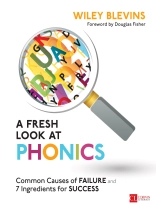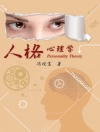‘In most instances, there isn’t one main cause of a systematic breakdown in phonics instruction. Rather, a combination of causes can create a perfect storm of failure.’
—Wiley Blevins
Picture a class of kindergarteners singing the alphabet song, and teaching phonics seems as easy as one-two, three, A, B, C, right? In a Fresh Look at Phonics, Wiley Blevins explains why it can get tricky, and then delivers a plan so geared for success, that teachers, coaches, and administrators will come to see owning this book as a before and after moment in their professional lives.
In this amazing follow up to his renowned resource Phonics From A-Z, Wiley uses the data he has collected over two decades to share which approaches truly work, which have failed, and how teachers can fine-tune their daily instruction for success.
You will learn to focus on the seven critical ingredients of phonics teaching that produce the greatest student learning gains— readiness skills, scope and sequence, blending, dictation, word awareness, high frequency words, and reading connected texts. Then, for each ingredient, Wiley shares:
- Activities, routines, word lists, and lessons that develop solid foundations for reading
- Ideas for differentiation, ELL, and advanced learners to ensure adequate progress for all learners
- Help on decodable texts, what not to over-do, and what you can’t do enough of for your students’ achievement
- Interactive ‘Day Clinic’ activities that facilitate teacher self-reflection and school wide professional learning
In a final section, Wiley details the ten common reasons instruction fails and shows teachers how to correct these missteps regarding lesson pacing, transitions, decodable texts, writing activities, assessment and more. A Fresh Look at Phonics is the evidence-based solution you have been seeking.
Wiley Blevins, Ph.D., is a world-renowned expert on early reading, and author of the seminal book Phonics From A-Z among many other works. He has taught in both the United States and South America, and regularly trains teachers throughout Asia. He holds a Doctorate in Education from Harvard University, and has worked with numerous educational scholars, including Jeanne Chall, Isabel Beck, Marilyn Adams, Louisa Moats, and Dianne August, and others.
Cuprins
Section 1: The Key Ingredients for Phonics Success
Success Ingredient 1: Readiness Skills
Background and Key Characteristics
Best Practices and Look-Fors for Success
Common Instructional Pitfalls
Day Clinic: Examine Your Practices
Next Steps to Leap Forward
Success Ingredient 2: Scope and Sequence
Background and Key Characteristics
Best Practices and Look-Fors for Success
Common Instructional Pitfalls
Day Clinic: Examine Your Practices
Next Steps to Leap Forward
Success Ingredient 3: Blending
Background and Key Characteristics
Best Practices and Look-Fors for Success
Common Instructional Pitfalls
Day Clinic: Examine Your Practices
Next Steps to Leap Forward
Success Ingredient 4: Dictation
Background and Key Characteristics
Best Practices and Look-Fors for Success
Common Instructional Pitfalls
Day Clinic: Examine Your Practices
Next Steps to Leap Forward
Success Ingredient 5: Word Awareness Activities (Word Building and Word Sorts)
Background and Key Characteristics
Best Practices and Look-Fors for Success
Common Instructional Pitfalls
Day Clinic: Examine Your Practices
Next Steps to Leap Forward
Success Ingredient 6: High-Frequency Words
Background and Key Characteristics
Best Practices and Look-Fors for Success
Common Instructional Pitfalls
Day Clinic: Examine Your Practices
Next Steps to Leap Forward
Success Ingredient 7: Reading Connected Text
Background and Key Characteristics
Best Practices and Look-Fors for Success
Common Instructional Pitfalls
Day Clinic: Examine Your Practices
Next Steps to Leap Forward
Plus One More Essential Success Ingredient: You!
Section 2: 10 Common Causes of Phonics Instruction Failure
Introduction
Reason 1: Inadequate or Nonexistent Review and Repetition
The Problem
How to Fix It
Reason 2: Lack of Application to Real Reading and Writing Experiences
The Problem
How to Fix It
Reason 3: Inappropriate Reading Materials to Practice Skills
The Problem
How to Fix It
Reason 4: Ineffective Use of the Gradual Release Model
The Problem
How to Fix It
Reason 5: Too Much Time Lost During Transitions
The Problem
How to Fix It
Reason 6: Limited Teacher Knowledge of Research-Based Phonics Routines and Linguistics
The Problem
How to Fix It
Reason 7: Inappropriate Pacing of Lessons
The Problem
How to Fix It
Reason 8: No Comprehensive or Cumulative Mastery Assessment Tools
The Problem
How to Fix It
Reason 9: Transitioning to Multisyllabic Words Too Late
The Problem
How to Fix It
Reason 10: Overdoing It (Especially Isolated Skill Work)
The Problem
How to Fix It
Closing Thoughts
References
Despre autor
Wiley Blevins, Ed.D., studied at the Harvard Graduate School of Education and Bowling Green State University. He is an author, educational consultant, and researcher, and has taught both in the United States and South America. Wiley has written over 17 books for teachers, including A Fresh Look at Phonics, Phonics From A to Z, Differentiating Phonics Instruction for Maximum Impact, and Choosing and Using Decodable Texts. He has authored several phonics and reading programs and wrote the phonics brief by the International Literacy Association (Meeting the Challenges of Early Literacy Phonics Instruction). Wiley′s current focus is on adaptive technology, differentiated professional development, and children′s literature. Wiley has written over 100 children′s books and is SVP and Associate Publisher at Reycraft Books, a new imprint focused on publishing books by authors and illustrators from under-represented groups.












